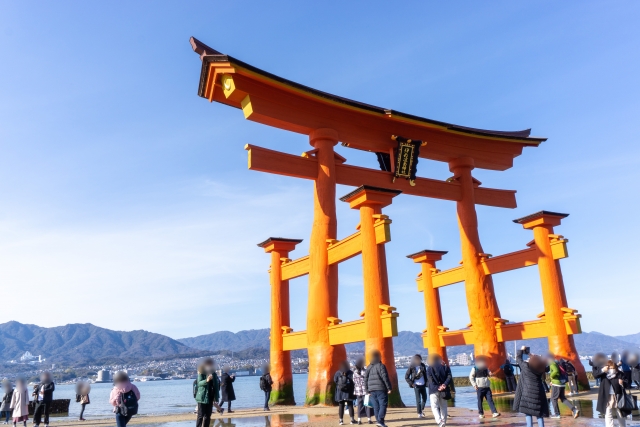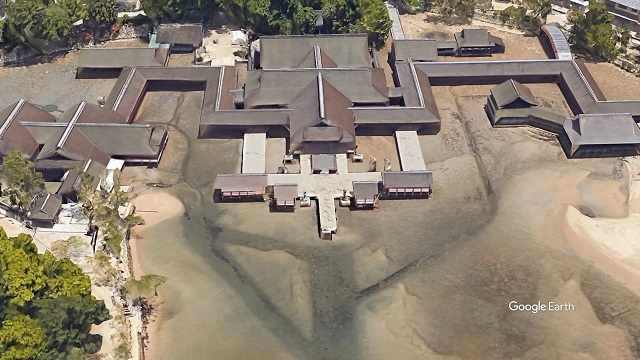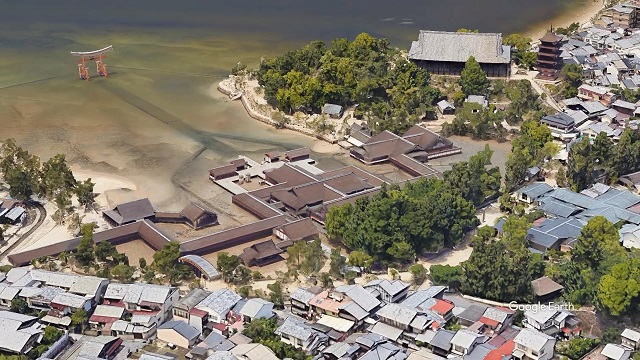Itsukushima Shrine, located on Miyajima, Hiroshima Prefecture, is one of the three most scenic spots in Japan, and is a shrine that symbolizes Japan’s history and culture.
Its characteristic architecture and historical background attract many tourists and believers.
In this article, we will introduce Itsukushima Shrine, which is famous for its large torii gate that stands above the sea.
Overview and characteristics of Itsukushima Shrine
Itsukushima Shrine is a shrine located in Miyajima (Itsukushima), Hiroshima Prefecture, and is known as one of the three most scenic spots in Japan.
The shrine is located at the northern foot of Mt. Misen in the northeastern part of Miyajima in Hiroshima Bay, and its history dates back to ancient times.
Itsukushima Shrine was deeply worshiped by the Heike clan, and Taira no Kiyomori built the large-scale shrine building that stands on the sea today.
Currently, six buildings, including the main shrine, worship hall, and corridor, have been designated as national treasures, and 14 buildings have been designated as important cultural properties.
One of the features of the shrine is the large torii gate, which stands 16 meters above the sea and is one of the three major torii gates in Japan.
Itsukushima Shrine is known for its annual summer festival, the Kangen Festival, during which traditional music and dance are offered.
Itsukushima Shrine is a place that symbolizes Japanese history and culture and is a tourist spot worth visiting.
Otorii

This large torii gate stands 16 meters high on the sea, and is one of the three largest torii gates in Japan.
The Otorii gate is famous for its appearance floating on the sea, but if the conditions are right, you can walk to it.
It is a very rare marine shrine.
Wooden stakes are likely to corrode easily, so they are regularly inspected and repaired.
Architecture and preservation of Itsukushima Shrine

The construction techniques of shrines are special, and although they are located on the sea, they are constructed in the same way as buildings on land.
The basic method used is to lay a foundation stone, set up piles (bundles), and then lay a wooden floor on top of it.
Because the wooden stakes are submerged in seawater, they are regularly inspected and repaired to prevent corrosion.
In particular, the flat stage uses stone pilings, which are said to be extremely durable. The main building of this shrine is often damaged by natural disasters such as typhoons and storm surges.
Parts of the main shrine, such as the Noh stage and Monkeki Shrine, are said to be susceptible to damage from typhoons, so repairs are frequently carried out.
On the other hand, the main buildings such as the main shrine and worship hall are said to have never been submerged in water throughout its long history.
These unique elements of Itsukushima Shrine’s architecture and preservation can be enjoyed as an interesting perspective when visiting this shrine.
Its durability and unique construction techniques impress visitors and offer a glimpse into Japanese architectural culture.


Basic information about “Itsukushima Shrine”
| Info | Itsukushima Shrine ■Location 1-1 Miyajimacho, Hatsukaichi City, Hiroshima Prefecture ■Parking lot none ■Inquiries Tel:0829-44-2020(9:00~16:00) ■Website https://www.itsukushimajinja.jp/ |
| Map | |
| Train | JR West Miyajimaguchi Station Hiroshima Electric Railway Hiroden Miyajimaguchi Take the ferry from Miyajimaguchi Pier to Miyajima Pier (about 10 minutes) on foot shrine entrance |
| Car | From Sanyo Expressway Hatsukaichi IC to Miyajimaguchi (about 15 minutes) From Sanyo Expressway Ohno IC to Miyajimaguchi (about 15 minutes) Unknown during traffic jams on Saturdays, Sundays, and holidays |
SNS posting(#厳島神社)
Find and make reservations for nearby restaurants
Find a good restaurant and have the best tour!


Comments